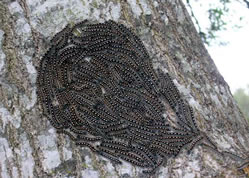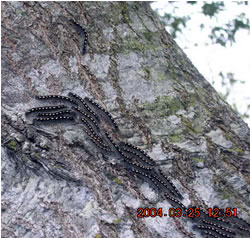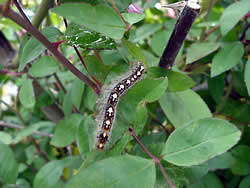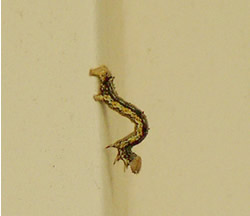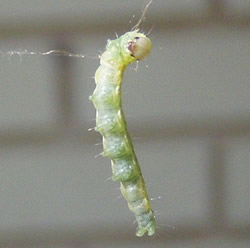Search
For The Answer
Click here to access our database of
Plant Answers
Search
For The Picture
Click here to access the Google database of plants
and insects
Information
Index
Alphabetical Listing of Topics, Recommendations
and Plants
Milberger's Nursery and Landscaping
3920 North Loop 1604 E.
San Antonio, TX 78247
210.497.3760
nursery@milbergersa.com
Open 9 to 6 Mon. through Sat.
and 10 to 5 on Sun.

Three exits east of 281, inside of 1604
Next to the Diamond Shamrock station
Please click map for more detailed map and driving directions.
“Worms”—Forest Tent-less Caterpillar
Those crawly, creeping, hairy creatures which tickle our body parts after unsuspectingly leaping from nearby trees—sharpening the screaming ability of non-nature lovers, invading premises by scaling walls, staining swimming pools with their body carcasses and presenting a grotesque display when gathering in teaming masses on the trunks of trees. These creatures-of-crawl are usually referred to as "worms", as well as several other not-printablables! However, the term "worm" is not scientifically correct. A worm is a legless animal with a slender, soft body. True worms are made up of many cells. But they do not have a backbone. Most people think of the worm-like larvae (young) of butterflies and other insects as "worms". But scientists who study animal life consider only certain adult animal as true worms. The creature that most recently has begun invading our privacy is really a caterpillar. A caterpillar is a worm-like creature that is the second, or larval, stage in the life history of butterflies and moths. When a butterfly egg hatches, a tiny caterpillar crawls out and begins to eat. The caterpillar grows, but its skin does not grow with it, as does the skin of most animals. Soon the skin becomes too tight and the caterpillar prepares to throw it off. A split appears on the upper part, near the head end, and the caterpillar wriggles out. It appears in a new soft skin formed under the old one. In a few days this, too, is outgrown, and the process is repeated a number of times. Caterpillars are heavy eaters. A butterfly or moth does all its growing during the caterpillar stage. The larva stores up the tissues that later are transformed into the adult insect. The adult grows no more after it grows wings. The culprit that most folks are "excited" about nowadays is the forest tent caterpillar. They get their name because their eastern relatives named appropriately, the eastern tent caterpillar, spins a loose, white web that looks like a tent. This web envelops tree twigs and is the home for a group of caterpillars. However, the "worm" which we love to hate is the forest tent caterpillar and, even though the term "tent" is included in the insect's nomenclature, the forest tent caterpillar does not build a tent (hmm—must be an Aggie deal!). The name confuses people into believing that this is the webworm that does definitely build webs in trees in this area. However the webworms, which spin webs over the foliage on which they feed in the summer, can sometimes cover whole branches and trees with their webs. These two worm pests have completely different appearances. Our little swimming pool buddies, the forest tent caterpillar, is tent-less, have a row of yellow spots along its back. It is black and hairy with blue spots on the sides of its cuddly, little body. The webworm, in contrast, is a much smaller creature (about one inch when full grown) which is pale yellow or green with a broad, dusky stripe running down the back, bordered on each side by a yellow stripe. The webworms are covered with tufts of long WHITISH hairs. Who cares what they look like or what is their name? Where do these devils come from and how can they be killed? In midsummer the female moth of the forest tent-less caterpillar lays brown egg masses on tree twigs. The eggs hatch the following spring (in April). After feeding for about six weeks, the larvae enter the pupa stage in which they spin silky cocoons around themselves. After three weeks, they emerge as full-grown moths, mate, lay their eggs, and die. Webworms overwinter as pupae in silken cocoons under ground trash or on rough tree bark. Moths emerge to disperse and deposit eggs in hair?covered masses on the underside of leaves. Anything that kills can be used. A fly swatter, a big foot, boiling water and automobile tires which will crush their creepy, little bodies are effective. If you are a mass murderer and want to use an insecticide, any will work. The legal-to-use insecticides for forest tent-less caterpillar are carbaryl (Sevin), Malathion and acephate (Orthene). These are the what-you-spray-you-kill insecticides, i.e., if the caterpillars are on a brick wall, which hopefully they are not eating, you have to spray them with a contact-kill insecticide. If you locate the foliage that they are feeding on, you can spray with these insecticides or use the super-safe, organically approved Bacillus thuringiensis (Dipel, Thuricide, Bactur, Biological Worm Killer) insecticide. Bacillus requires a several day waiting period before the worm actually dies, even though they cease feeding activities immediately. So, for those of you who are immediate-gratification killers, you should carefully use one of the other products mentioned. FOLLOW LABEL INSTRUCTIONS—remember, you can only kill each caterpillar ONCE and dead IS dead. The black "tanglefoot" products are not as effective on the masses of worms as insecticide sprays. Sticky substances do not keep the "worms" out of the trees since the female moth of the forest tent-less caterpillar lays brown egg masses on tree twigs. If you could remove the wings of the moth, maybe the sticky stuff would do some good. The caterpillars that you see on the trunks of trees are not having a revival; they are shedding their old skin. Remember, the caterpillar grows but its skin does not grow with it, as does the skin of most animals. The skin becomes too tight and thecaterpillar prepares to throw it off—they feel like you do after wearing a too tight girdle all night; something has got to give! In a few days, after eating for 24 hours every day, the new skin is outgrown and the process is repeated. This occurs a number of times. Now you know the real name of the "worm" with which you have become so intimate with during the past week or so and how to "get some satisfaction". These pests will disappear in a couple of weeks and will only be fond memories until next spring about this time when THEY SHALL RETURN!
|
||||||||||




